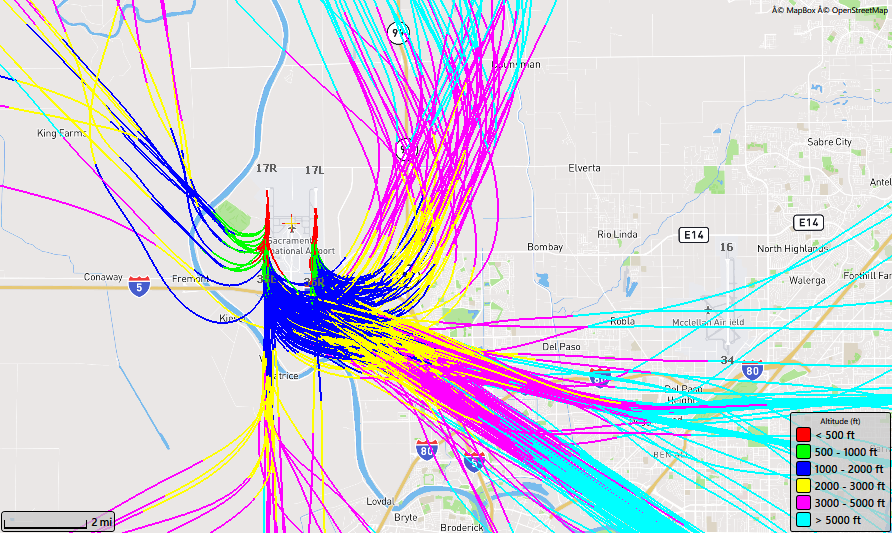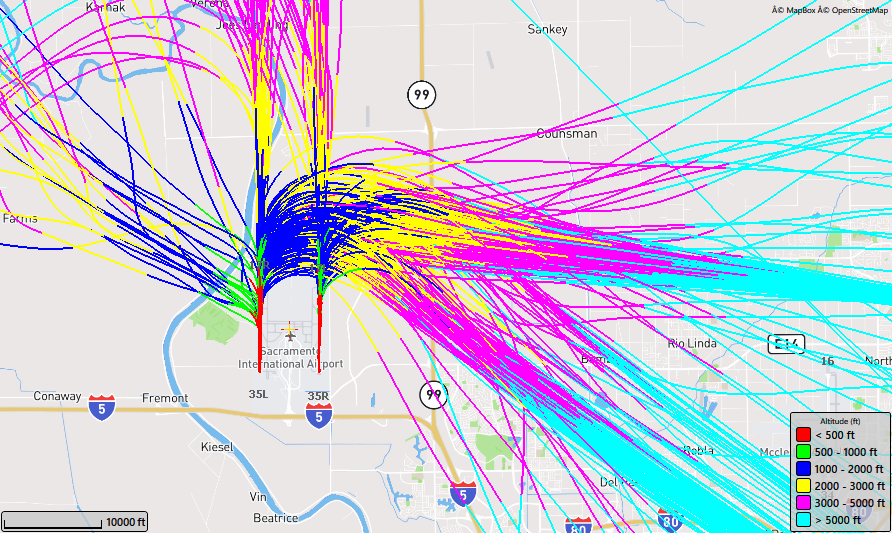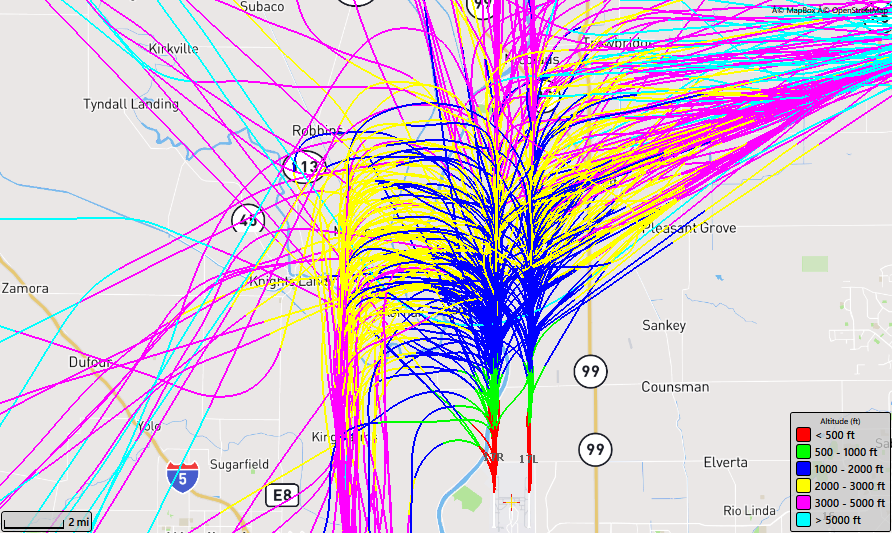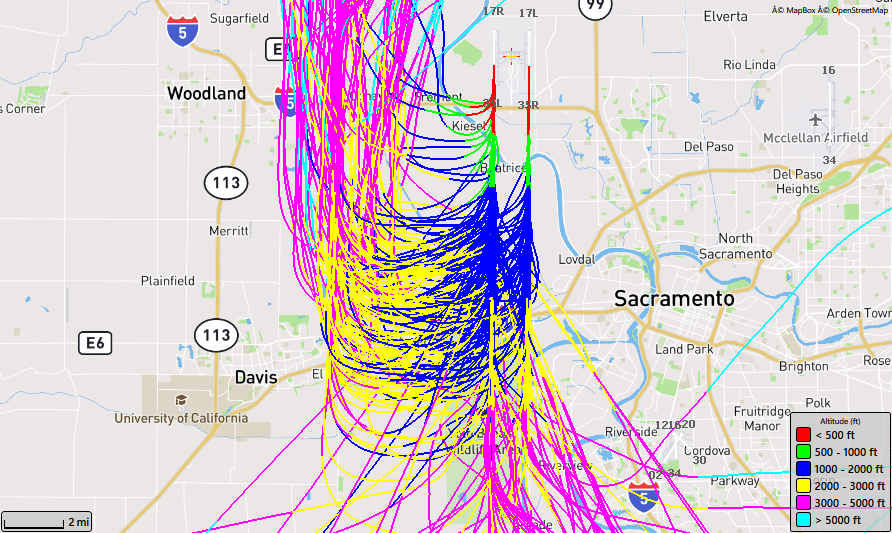-
About
- General Information Learn more about the Sacramento County Airport System. Click here for information such as the system’s mission statement, awards, partners and more.
- News & Events Keep up with everything happening at the Sacramento County Airport System and our airports. Past, present and future news, press releases and events.
- Community Outreach & Customer Service Social Media. Speakers Bureau. Customer Service. PR. Be part of our conversation with the community.
- Planning & Design Interested in the master plan for future expansion and development of airports within our system? Everything you need to know is right here.
- Safety Management Systems Find out about our systematic and structured approach to safety management as well as access to our online form for reporting a safety concern.
- WRAPm 2022 Western Region Airport Property Managers
- Reports Peruse reports and information on airport system issues.
- Aviators Restaurant Survey Files Executive Airport survey summary, survey data, and paper survey copies.
-
Opportunities
- Employment (Jobs) The Sacramento County Airport System and our partners are always looking for new team members. Explore jobs throughout the system here.
- Concessions Resources for Developing a Concessions Business
- Bids & Requests Current proposals, bids and requests are listed here.
- Leasing With leasing opportunities at 3 different airports, the County Airport System has the right space to fit your needs. Explore available spaces here.
- Permits Permits are critical to doing business with the Sacramento County Airport System for purposes such as demonstrations, transportation, film and events.
- Advertising More than 10 million passengers pass through SMF every year, making it the perfect place to share your company's message.
- ACDBE/DBE Programs The Sacramento County Airport System is dedicated to helping minority and women-owned businesses through ACDBE/DBE Programs
-
Environment
- Noise The Sacramento County Airport System has a long history of working with stakeholders to reduce aircraft noise exposure for local residents.
- Wildlife Management The County Airport System is dedicated to ensuring public safety through our comprehensive Wildlife Hazard Management Program.
- Water Conservation Water is one of our most precious resources. Learn what Sacramento International Airport is doing to reduce water consumption
- Sustainability We’re working to make flying greener. Find out more about our efforts to reduce the energy use and overall ecological impact of our airports.
- Contact Us
-
Search
Live / Visit
Business
Sacramento County
Select Language
- Department of Airports
- International (SMF)
- Mather (MHR)
- Executive (SAC)
- Franklin (F72)
Select Language
Frequently Asked Questions
Find answers to common questions here.
The Sacramento County Department of Airports (Department) manages the Sacramento County Airport System, which is comprised of Sacramento International Airport (SMF or the Airport), Mather Airport (MHR), Sacramento Executive Airport (SAC), and Franklin Field (F72).
The Federal Aviation Administration (FAA) is the federal governmental body charged with regulating all aspects of civil aviation in the United States.
Have the flight paths changed?
Answer:
Changes in wind and weather conditions may result in a change to the runways being used. Residents may interpret this as a change in flight paths when in actuality it is a different runway being used than what may occur most of the time.
Runways are built to align with the general wind pattern for the area. The runways at SMF are oriented north-south and as a result SMF operates in either north-flow (take offs and landings to the north) or south-flow (take offs and landings to the south). Aircraft operate to the south, in south-flow, the majority of the time during any given year. South-flow occurs approximately 70 percent of the time in a given year; north-flow occurs approximately 30 percent of the time in a given year.
Because aircraft are designed to operate in this manner, air traffic controllers monitor winds at both the surface and at higher altitudes above ground level, known as the “winds aloft”. Winds aloft can originate from different directions than winds at ground levels and may dictate the direction of departures or landings at the airport. Air traffic controllers consider both surface and winds aloft forecasts to determine which direction is safest and when a change in runways is warranted.
In short, though light winds on the surface may be coming from the north, it is still possible that aircraft will take off and land to the south due to the winds aloft. Forecast winds may favor one direction for an extended period time, but within a forecast period there may be short periods where winds shift. Such instances can result in local surface winds being different from those at the airport or aloft that are used to determine the optimal direction for traffic during a given forecast period.
Safety is never compromised as all aircraft have some capability to operate with crosswinds or even tailwinds, but safety margins are highest when aircraft can land or takeoff into the wind, especially as winds get stronger.
South Flow Jet Departure Flight Tracks |
North Flow Jet Departure Flight Tracks |
South Flow Jet Arrival Flight Tracks |
North Flow Jet Arrival Flight Tracks |
Maps show jet flights by altitude. Click to enlarge.
Can we change the flight paths?
Answer:
The FAA is the only entity with the authority to design, implement, enforce, and move flight paths. The FAA is on record as stating it will not change flight paths if the safety and/or efficiency of the airspace is compromised or if noise is shifted from one community to another. To date, no alternative has emerged (including due south departures) that meets these requirements. Thus, the FAA’s current airspace design in Sacramento remains the agency’s preferred option.
The FAA's primary mission is to ensure the safety and efficiency of our nation's navigable airspace. The agency only prohibits aircraft overflights of a particular geographic area for vital national security or safety considerations.
The United States Department of Defense is the only other entity able to prohibit overflights of a certain geographical area, typically national security critical areas, military installations and training areas.
Air traffic from Sacramento’s Mather and Executive Airports and Franklin Field, as well as McClellan Airfield, are operating in the same regional airspace and must avoid encroaching upon SMF’s traffic flow. Incorporating additional activity such as law enforcement operations leaves little room for deviation from established flight paths. Airlines create their own schedules based on market demand. Therefore, operations can occur at any time of day, furthering the need for pre-designated airspace routes.
Why doesn’t the south-flow departure path extend south over the Yolo Bypass instead of southeast over populated areas?
Answer:
Flight paths are defined by the airspace configuration, which is driven by the location of surrounding airports and their associated arrival and departure corridors. The concept of departing over the Yolo Bypass has been examined and rejected by the FAA. The SMF arrival route is south of the Airport and the Travis Air Force Base airspace is just to the southwest of the Airport. These airspace constraints were cited by the FAA as the primary reason for rejecting a Yolo Bypass departure procedure.
The National Airspace System (NAS) is a deeply complex “web” of flight paths in which aircraft operations require precision and strict management to not put competing air traffic in the same region in any danger. In addition to the FAA being on record as stating it is against FAA policy to move flight paths because of noise unless safety and efficiency are not adversely impacted and noise is not moved onto other recipients, it is not possible to move flight tracks at SMF without affecting the overall NAS.
Every flight that currently departs to the south or southwest is required to have its flight path and timing coordinated with both the incoming SMF arrival stream from the south by FAA Terminal Radar Approach Control Facilities (TRACON) and by the United States Air Force (USAF) Air Traffic Control unit which controls airspace around Travis Air Force Base. While this can be done on a case by case basis (though those flights do often have to wait at the end of the runway for a departure clearance), it is very inefficient to do so on a regular basis and during periods of high traffic volume, either at SMF or Travis AFB.
The dedication of airspace encompassing Travis AFB southwest of SMF is an ongoing constraint to the FAA’s ability to safely and efficiently route aircraft south and southwest of SMF and one unlikely to be eliminated as the USAF and Department of Defense (DOD) have consistently declined to release Travis AFB airspace to civilian use and/or control. The DOD has preferential use and control of vast tracts of airspace for its installations and operations throughout the United States.
I live in Davis or West Sacramento. Why are there aircraft flying over my home?
Answer:
It is during north-flow conditions that locations to the south and west of SMF may experience more frequent overflights by arriving aircraft. Aircraft from the east and south are aligning with the runways to land to the north. Aircraft on approach align with the runway at seven to 10 miles from the touchdown point. This is typically farther away from the airport when compared to where departures may initiate a turn. North-flow conditions occur approximately 30 percent of the time in a given year.
Overflights of these communities are likely to continue until such time as the FAA determines other procedures are available that do not reduce safety or operational efficiency or that do not move noise onto other communities. To date, no alternative has emerged that does not result in such unacceptable impacts. Thus, the FAA’s current airspace design in Sacramento remains the Agency’s preferred option.
North Flow Jet Arrival Flight Tracks by Altitude
Can the airplanes be required to fly higher?
Answer:
Aircraft operators have always had to abide by the Federal Aviation Regulations (FAR) Part 91.119, which states in part that, “except when necessary for departure or landing, the minimum altitude over urban areas is 1,000 feet and 500 feet over rural areas.” Local and state authorities do not have jurisdiction over airspace regulations and, therefore, cannot mandate that aircraft fly at higher altitudes.
The Department has no authority to direct the FAA, airlines, or pilots to fly a specific departure profile, and FAA regulations actually preclude airports or local jurisdictions from adopting and enforcing any such restriction locally.
Aircraft performance is affected by multiple factors including winds, air density, and weight, which can result in differences between the altitudes flown by individual aircraft during departure. Aircraft performance may be particularly affected during Sacramento’s typically hot summer months. Ultimately, each airline has an FAA-approved operational procedure for each aircraft type it flies that include departure profiles for a variety of conditions that may be unique to each flight. These procedures are standardized for safety, and are typically flown the same way regardless of airport or direction of flight.
There are aircraft flying over my home at 5 AM or earlier and sometimes until midnight or later. Why won’t the airport control this?
Answer:
The Department is not able to dictate arrival or departure times, restrict certain aircraft from operating at SMF, turn down a carrier that wishes to operate at SMF, or fine an airline for not complying with a noise abatement procedure.
Airports which accept federal funding of any type are required to comply with federal Grant Assurances, (promises to follow specific rules), which require 24/7/365 open access to all aircraft that can do so in accordance with applicable FAA regulations and procedures. The aircraft operators such as the airlines create their own schedules of operations.
The Airport Noise and Capacity Act (ANCA), severely limits airport operators’ ability to implement access restrictions such as curfews. Under ANCA, the airport operator must undertake a successful Federal Aviation Regulations (FAR) Part 161 Study demonstrating, among other qualifying factors, that the curfew/access restriction reduces or eliminates incompatible land uses while not reducing safety or efficiency. FAR Part 161 requires that airport proprietors examine the costs and benefits of a proposed noise or access restriction within an “airport noise study area” with a goal of reducing the amount of incompatible land uses. That area must include all property that lies within the 65 Day/Night Average Sound Level [DNL] (or Community Noise Equivalent [CNEL] in California) contour. There are no incompatible land uses within SMF’s 65 CNEL contour, therefore an FAR Part 161 Study is not an eligible undertaking. It is important to note that modeled noise contours (DNL, CNEL) are not the same as actual noise measurements.
It is important to note that modeled noise contours (DNL and CNEL) are not the same as actual single-noise-event measurements. Single-noise-event measurements are accounted for in a cumulative sense by way of noise modeling. Federal regulations require the use of noise models to quantify future aircraft noise exposure based on forecast aircraft operations (count of operations) and fleet mix (types of aircraft performing operations).
Since the introduction of ANCA, no air carrier airport has been successful in restricting aircraft operations on the basis of noise under the Part 161 process.
Get more information on Part 161 studies below.
Part 161 studiesWho regulates aircraft noise?
Answer:
The FAA regulates the noise levels aircraft are legally allowed to generate through the aircraft certification process, standards for which are defined in the Code of Federal Regulations Part 36. Global standards are established by the International Civil Aviation Organization (ICAO), known as "stages," and the FAA recognizes those standards when establishing its policies.
As aircraft certification and operations are regulated at the federal level by the FAA, aircraft noise levels are outside the jurisdiction of state, county, or municipal government adopted codes or regulations, such as local noise ordinances.
What can the Department of Airports do to minimize aircraft noise impacts?
Answer:
The Department promotes compatible land use planning near the Department-owned airports. The Department regularly reviews and comments on proposed developments near its facilities. Ultimately, it is the responsibility of the permitting jurisdiction to consider the Department’s comments and recommendations and decide what, if any, conditions they may place on the proposed development (including disclosure notices or easements) and then of the property seller to fully abide by those conditions as part of any property transaction.
The Department maintains information on its website and makes staff available upon request to assist prospective homebuyers in understanding current and anticipated impacts from aircraft overflight activity so they can make their own informed decisions.
I have submitted noise complaints to the Department of Airports. They have responded that the issue is within the jurisdiction of the FAA. The FAA has told me this issue is within the jurisdiction of the Airport. What is the role of the FAA and what is the role of the Department of Airports?
Answer:
The authority to design, implement, and enforce flight paths and all applicable regulations lies exclusively with the FAA. The Department is tasked with mitigating noise impacts when there are determined to be incompatible land uses. The FAA defines aircraft noise impacts as affecting incompatible land uses, such as residential, which are within the 65 Day/Night Average Sound Level [DNL] (or Community Noise Equivalent [CNEL] in California) noise contours. At this time there are no incompatible land uses within the 65 CNEL at SMF.
The Department mitigates noise impacts by advocating for specific nearby land uses (e.g. industrial over residential, etc.), working with the appropriate planning agencies to comment on the current and future (projected based on flight forecasts) nature of overflights of a specific area (e.g. housing or educational developments), and educating the public on flight procedures and how they interact with and affect the National Airspace System.
If in the judgment of the Department it appears a standard operating procedure or even a Federal Aviation Regulation has not been adhered to for an unexplainable reason, the Department may at its discretion attempt to bring the situation to the attention of either the aircraft operator (if identified) or the FAA in the hopes of avoiding an unnecessary reoccurrence.
Recording and responding to noise complaints is also a duty of the Department. While it is understandable that callers will want the Department to implement immediate action to address their concern, such action is almost always beyond our authority to implement. The Department investigates concerns in order to explain the circumstances to the caller and further understanding of the situation.
What is NextGen? Did the public have the chance to comment on its implementation?
Answer:
As defined by the FAA: The Next Generation Air Transportation System (NextGen) is an ongoing modernization project of the United States National Airspace System. NextGen is not one technology, product, or goal. It encompasses innovative and transformative technologies that are being developed and deployed after thorough safety testing.
As part of the FAA’s NextGen program, the FAA initiated the Northern California Optimization of Airspace and Procedures in the Metroplex (NORCAL OAPM) project. The effort included preparation of an Environmental Assessment for the project, which ultimately resulted in a finding of no significant impact. Public involvement is discussed in detail in Appendix A of the document. The FAA held a Public Information Workshop in Terminal A at SMF on April 14th, 2014. NORCAL OAPM documentation can be accessed on the FAA’s website.
NextGen has continually introduced new technologies to improve air travel. The FAA plans to keep introducing cutting-edge technologies, procedures, and policies that benefit passengers, the aviation industry, and the environment through 2025 and beyond.
NORCAL OAPM documentationIs NextGen the reason why Natomas seems to be experiencing so many overflights now?
Answer:
The specific experience in northwest Natomas is the result of a general traffic increase by the airlines at SMF, not exclusively NextGen. Airlines fly at a frequency driven by public demand and will increase or reduce flights as the market warrants. This is also beyond the control of the Department.
Pre-COVID-19, SMF was breaking its own all-time records for passenger traffic on an annual and individual-month basis, when travel increased to historic highs. Growth is expected to return to 2019 levels and continue as air travel recovers, post-COVID-19.
In areas where NextGen departure procedures have been implemented, some residents have reported an increase in the frequency of noise events due to the precise navigation of the procedures and a resulting concentration of flight paths.
Aside from noise, we are concerned aircraft pollutants and health effects from overflights are compromising our neighborhood and our atmosphere. What can be done about this?
Answer:
As part of the certification process, aircraft manufacturers must meet increasingly stringent emissions standards established by federal law and go through routine maintenance checks that ensure all equipment remains within federally established acceptable and safe operating parameters.
Learn more about the Department of Airports’ sustainability efforts below.
Neither the state nor any local government has jurisdictional authority over aircraft emissions of any type. Only federal policies may influence emissions levels from aircraft. While the purpose of FAA NextGen flight procedures is to make the air traffic system safer and more efficient, they also reduce aircraft exhaust emissions by taking advantage of more precise and efficient routing. The Sacramento area has some the worst air quality in the nation – emission reductions are import to achieving cleaner air goals.
Sustainability EffortsI have seen in the media and heard from neighbors that SMF is building a new runway. Why wasn’t I informed?
Answer:
There is not a new runway (actual or planned) at SMF. The Airport’s 2004 Master Plan had a proposed third parallel runway on the far west airfield based on traffic projections. It has since been determined that a third runway is unnecessary and will not be constructed. The 2020 SMF Airport Master Plan does not include a third runway.
An extension to the north end of the east runway is listed on the official Airport Layout Plan approved by the FAA and was identified in the recently produced 2020 SMF Airport Master Plan with a proposed timeline of approximately 2038. However, due to COVID-19, some Master Plan projects may be deferred to even later years than those initially identified.
It is important to note that the Master Plan itself is not used for addressing noise concerns – the required associated environmental study is the appropriate avenue for commenting on noise or other environmental-related issues. The Environmental Impact Report for the 2020 SMF Airport Master Plan Update is being drafted and will be made available for public review and comment in 2021 by the Sacramento County Department of Planning and Environmental Review.
How can I track the aircraft flying over my neighborhood?
Answer:
The Department makes aircraft flight tracks available for interactive investigation and viewing by the public below.
Note that depiction of aircraft operations are delayed by approximately two hours for data processing.
Aircraft Flight TracksI am contemplating the purchase of a home in the Sacramento area. How can I learn more about potential overflights and exposure to aircraft noise at that location?
Answer:
While property sellers and realtors are required by California state law to disclose a home’s proximity to the airport if it is within an Airport Influence or Reference Area or within two miles of an airport, the Department strongly recommends that prospective homebuyers do their own research. The Department is happy to provide information for Prospective Homebuyers to anyone considering buying a home in the area.
Please use the following link to our website for more information:
Homebuyer InformationI have a complaint or inquiry regarding McClellan Airfield or another local airport. Where do I submit that?
Answer:
The Sacramento County Department of Airports operates four airports: Sacramento International Airport, Sacramento Mather Airport, Sacramento Executive Airport, and Franklin Field.
For complaints or inquiries relative to McClellan Airfield, which is not part of the Sacramento County Airport System or managed by the Department of Airports, call (916) 292-8135 or email noise@flykmcc.com.
For complaints or inquiries relative to any other local airport or heliport, please contact the operator of that facility directly.
My question hasn’t been addressed or thoroughly answered here. Where can I get more information?
Answer:
You may contact the Department through the Noise Information Office by calling (916) 874-0800, emailing planenoiseinfo@saccounty.net, or filling out the form on our website here.
In order to correlate a reported aircraft noise event to an aircraft, an address is requested. Please allow up to one week for a response to detailed inquiries as we research and provide specific information relative to the event.
In addition to our website, you might find the following links helpful:
Airport Website
Translate



